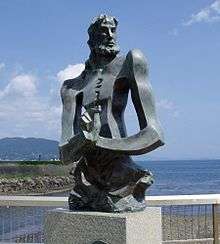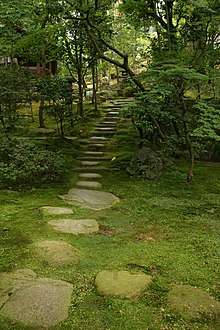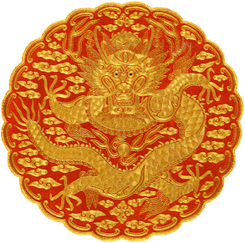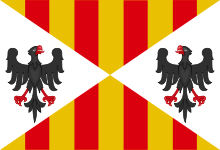List of foreign-born samurai in Japan

This is a list of foreign-born people who became samurai in Japan.
Definition

In this list, Japan means the Japanese archipelago. There are various theories as to the definition of samurai. This list includes the following people.
- Foreign-born people who were "shibun" (ja:士分): soldiers who had the official status of samurai after the establishment of the Tokugawa Shogunate.[1][2][3]
- Before the Edo period when classification of shibun had not been established, foreign-born soldiers who were given a territory or rice as salary by their lord as a shibun.
- Foreign-born people who were granted the official post of samurai, for example Hatamoto and Koshō (ja:小姓,[4] page).
The following people are treated as "Other foreign-born people who were allowed to wear two swords"
- Foreign-born people who weren't shibun, but were allowed to wear a pair of samurai swords (daishō) by the lord.[5]
The following people are treated as "people who could be foreign-born samurai".
- "Foreign-born samurai" whose existence is uncertain.
- Foreign-born people who served samurai, whose occupations were unclear.
- Foreign-born people who were given a territory or rice as salary by lords, whose occupations were unclear.
This list excludes the following people.
- Samurai of foreign ancestry born in Japan.
- Foreign-born people who served samurai in other occupations, for example Confucianist or medical doctor.
- Foreign-born people who served samurai as oyatoi gaikokujin, not Japanese-style soldiers.
Foreign-born samurai
| Birthplace | Original name | Occupation before arrival in Japan | Year of arrival in Japan | Name in Japan | Lord | Occupation and achievements in Japan |
|---|---|---|---|---|---|---|
(now |
unknown | Valet of Alessandro Valignano, Italian Jesuit missionary[7][7] | 1579 | Yasuke 弥助[8] |
Oda Nobunaga[8]→ Oda Nobutada[8] |
Retainer who was given salary by Nobunaga.[9] Weapon bearer of Nobunaga.[10] He served in the Honnō-ji incident.[8] |
(now |
Kim Yeo-cheol (Kanji: 金如鉄)[12] |
Son of 金時省, civil officer of Joseon[12] | 1592[11] | Wakita Naokata 脇田直賢[11] |
Maeda Toshinaga→ Maeda Toshitsune[11]→ Maeda Mitsutaka→ Maeda Tsunanori |
1000 koku. On-Koshōgashira (Head of pages). Kanazawa machi-bugyō (Commissioner of Kanazawa city). He served in the Summer Campaign of Siege of Osaka.[11] |
(now |
Park Won-hyuk (Kanji:朴元赫)[13] |
Son of lord of small castle in Gyeonju[13] | 1594[14] | Akizuki Tanenobu 秋月種信[15][13] |
Chōsokabe Motochika→ Chōsokabe Morichika[13] |
Page of Chōsokabe. After Chōsokabe clan had been removed from Tosa province, he became a renowned Korean style tofu merchant.[13] |
(now |
Kim Hae (Kanji:金海)[16][17][18] |
Potter[16] | 1595[16] | Hoshiyama Chūji 星山仲次[16][18] |
Shimazu Yoshihiro[16] | 30 koku. Founder of Satsuma ware. He was given two swords.[16][17][18] |
| unknown[19] | Son of 曽清官, commanding officer of Joseon[19] | 1598[19] | Soga Seikan 曾我清官[19] |
Nakagawa Hidenari[19] | 150 koku.Page of Hidenari. [19] | |
| (Kanji:李聖賢)[20] | Son of Yi Bok-nam, commander of Joseon[20] | 1598[20] | Rinoie Motohiro 李家元宥[20] |
Mōri Terumoto→ Mōri Hidenari[20] |
100 koku. Adviser of Mori clan. He was the swordsman who received menkyo of Yagyū Shinkage-ryū.[20] | |
(now |
Jan Joosten van Lodensteijn | Mate of De Liefde, Dutch ship[21] | 1600[22] | Yayōsu 耶楊子 |
Tokugawa Ieyasu→ Tokugawa Hidetada |
Hatamoto.[21][23] Under the Tokugawa Shogunate, he chartered several Red Seal Ships. |
| William Adams | Mate of De Liefde, Dutch ship[21] | 1600[22] | Miura Anjin (the pilot of Miura) 三浦按針 |
Tokugawa Ieyasu→ Tokugawa Hidetada |
Hatamoto.[21][24]250 koku. Interpreter and shipwright of Tokugawa Shogunate. (Adams was the model for the character John Blackthorne in James Clavell's novel Shōgun (1975).) | |
| unknown | unknown | unknown | Yagyū Shume 柳生主馬[25] |
Yagyū Munenori[25]→ Yagyū "Jūbei" Mitsuyoshi→ Yagyū Munefuyu |
Retainer of Yagyū clan.200 koku?[26] He married the sister of Yagyū "Hyōgonosuke" Toshitoshi.[20] | |
| Henan,Ming (now |
(Kanji:藍会栄)[28] | The member of the inner circle of Ming dynasty [28] | After 1624[28] | Kawanami Genbei (First) 河南源兵衛[28] |
Shimazu Iehisa[28] | 300 koku. He was political refugee from Ming. Tōtsūji (Chinese translator) of Satsuma domain. He was given right to wear swords.[28] |
Other foreign-born people who were allowed to wear two swords
Strictly, they were not official samurai even though they looks compatible with the modern concept of "samurai". All men from samurai class were permitted to wear daishō. However, people from other social classes were sometimes allowed to wear swords. For example, Hijikata Toshizō, the famous swordsman and vice-commander of Shinsengumi was born as a son of farmer. Even though he wore daishō and engaged in police activity, he couldn't gain the title of the official retainer of bakufu until 1867.

| Birthplace | Original name | Occupation before arrival in Japan | Year of arrival in Japan | Name in Japan | Lord | Occupation and achievements in Japan |
|---|---|---|---|---|---|---|
| Ming[29] | unknown | Chinese martial artist[29] | Before 1635[29] | Denrinbō Raikei 伝林坊頼慶[29] |
Marume Nagayoshi[lower-alpha 1]→ Sagara Yorifusa[lower-alpha 2]→ Sagara Yorihiro[lower-alpha 3][29] |
He was the disciple of renown swordmaster Marume Nagayoshi. Later he became yamabushi and established ninja corps called Ura-Taisha[29][30] |
| John Henry Schnell[32] | Secretary of the Prussian consul Max von Brandt[32] | 1859[33] | Hiramatsu Buhei 平松武兵衛[34] |
Matsudaira Katamori | Military instructor of Aizu Domain and Shōnai Domain. He procured weapons to for Ōuetsu Reppan Dōmei.He served in Battle of Hokuetsu.[35] | |
| Eugène Collache | French Navy officer | 1868? | Korashi 古良史[36] |
Enomoto Takeaki | He fought for Ezo Republic and served in Battle of Miyako Bay.[37] |
People who could be foreign-born samurai
- Foreign-born people who were given a territory.
- Kawaminami Rishin (汾陽理心): Retainer of the Shimazu clan, who was given 597 koku. He was born as 郭国安 (Japanese pronunciation: Kaku Kokuan) in the Ming dynasty. He made a journey to Japan in 1559. Later he was scouted by Shimazu Yoshihisa, daimyo of Satsuma as retainer. During Imjin war, he went Joseon as the officer in charge of letters. He was said to hold secret communications with Ming at that time. Later, he served the Satsuma domain using his medical knowledge.[38] In 1598, Rishin appeared in Chinese document as Japanese general.[39]
- Kyo Gigo (許儀後): Physician to Shimazu Yoshihisa, who was given 410 koku.[40] He was the bureaucrat of Jiangxi of the Ming dynasty. In 1571, he was captured by wokou, and brought to Satsuma Province. He was scouted by Yoshihisa there. He went to Joseon with him during the Imijin war.[41]
- Foreign-born people who were given a salary.


- Other possible foreign-born samurai
.svg.png)





- Watanabe Kotonori (渡辺士式): Born as 孟二寛 (Japanese pronunciation: Mō Jikan) in the Ming Dynasty, he served the Asano clan using his medical knowledge.[52] His grandson, Takebayasi Takashige was a member of the Forty-seven Ronin.
See also
Notes and references
Notes
References
- ↑ "コトバンク 「士分(しぶん)」". Retrieved 2016-01-05.
- ↑ "コトバンク 「徒士(かち)」". Retrieved 2016-01-05.
- ↑ "『武家の生活』、三田村鳶魚、中央公論社、1997年より「足軽」". Retrieved 2016-01-05.
- ↑ "コトバンク「小姓(こしょう)」". Retrieved 2016-01-05.
- ↑ "コトバンク「苗字帯刀(みょうじたいとう)」". Retrieved 2016-01-05.
- ↑ Histoire Ecclesiastique Des Isles Et Royaumes Du Japon, 第 1 巻、p.444. Retrieved 2013-06-22.
- 1 2 "ジアン・クラッセ、「日本西教史」上巻、太陽堂書店、1925年、384頁". Retrieved 2015-08-04.
- 1 2 3 4 村上直次郎; 柳谷武夫(訳) (2002), イエズス会日本年報 上, 新異国叢書, 雄松堂出版, ISBN 484191000X
- ↑ "松平家忠、「家忠日記」、文科大学史誌叢書第2巻、吉川半七、1897年、54頁". Retrieved 2015-08-04.
- ↑ 『織田信長という歴史 『信長記』の彼方へ』、勉誠出版、2009年、311-312頁。
- 1 2 3 4 5 "笠井純一、「家伝 金(脇田)如鉄自伝[翻刻解説]」、金沢大学教養部論集. 人文科学篇、1990年、一頁" (PDF). Retrieved 2015-08-04.
- 1 2 "笠井純一、「家伝 金(脇田)如鉄自伝[翻刻解説]」、金沢大学教養部論集. 人文科学篇、1990年、7頁" (PDF). Retrieved 2015-08-04.
- 1 2 3 4 5 6 7 内藤 雋輔 (1976), 文禄・慶長役における被虜人の研究, 東京大学出版会 ,746-748頁
- ↑ 高知県編、「高知県史要 : 附・高知沿革略志、元禄大定目」、高知県、1924年、154頁
- ↑ He was also known as Akizuki Nagazaemon(秋月長左衛門). Do not confuse with 3rd daimyo of Takanabe Domain of same name
- 1 2 3 4 5 6 7 "コトバンク「星山仲次(ほしやま ちゅうじ)」". Retrieved 2018-09-21.
- 1 2 "コトバンク「薩摩焼(さつまやき)」". Retrieved 2018-09-21.
- 1 2 3 "西藩烈士干城録(三)、2012年、鹿児島県立図書館、84頁" (PDF). Retrieved 2018-09-22.
- 1 2 3 4 5 6 7 内藤 雋輔 (1976), 文禄・慶長役における被虜人の研究, 東京大学出版会 , 723-724頁
- 1 2 3 4 5 6 7 8 毛利 吉元; 山口県文書館 (1987). 萩藩閥閲録第四巻. 山口県文書館. pp. 143–142.
- 1 2 3 4 "森良和、「メルヒオール・ファン・サントフォールト」、2014年、82頁" (PDF). Retrieved 2015-08-04.
- 1 2 "森良和、「メルヒオール・ファン・サントフォールト」、2014年、81頁" (PDF). Retrieved 2015-08-04.
- ↑ Corr, Adams the Pilot: The Life and Times of Captain William Adams. Pp.158
- ↑ 『家康の家臣団: 天下を取った戦国最強軍団』、山下昌也、学研プラス、2011年
- 1 2 3 今村 嘉雄 (1967), 史料柳生新陰流 上巻, 人物往来社 ,65頁
- 1 2 根岸 鎮衛, 耳嚢 巻一
- ↑ "阿久根市観光サイト アクネ うまいね 自然だネ 阿久根市の魅力". Retrieved 2018-08-16.
- 1 2 3 4 5 6 7 高向 嘉昭. "近世薩摩における豪商の活躍とその没落について" (PDF). Retrieved 2018-08-16.
- 1 2 3 4 5 6 "嬉野忍者調査結果 弁慶夢想 (べんけいむそう)".
- ↑ "肥前兵法タイ捨流分布 片岡タイ捨流".
- ↑ "asahi.com(朝日新聞社):維新期の会津・庄内藩、外交に活路 ドイツの文書館で確認 - 文化トピックス - 文化". asahi.com. 2011-02-07. Retrieved 2017-12-18.
- 1 2 "Hirohisa Kawaguchi,HENRY SCHNELL AND JAPANESE IMMIGRATION TO THE UNITED STATES,347頁" (PDF). Archived from the original (PDF) on 2016-03-04. Retrieved 2015-08-04.
- ↑ 高橋義夫 『怪商スネル』 大正出版、1983年、7-9頁
- ↑ "Hirohisa Kawaguchi, HENRY SCHNELL AND JAPANESE IMMIGRATION TO THE UNITED STATES,348頁" (PDF). Archived from the original (PDF) on 2016-03-04. Retrieved 2015-08-04.
- ↑ 今高橋義夫 (1983), 怪商スネル, 大正出版 126‐127頁。
- ↑ 鈴木 明 (1984), 追跡 一枚の幕末写真, 集英社 Text "和書" ignored (help) ,34頁
- ↑ 『フランス人の幕末維新』M. ド・モージュ、アルフレッド ウェット、ウジェーヌ コラッシュ著、市川慎一、榊原直文訳、有隣堂、1996年、83-84,88-91頁
- ↑ 本藩人物誌:鹿児島県史料集(13), 鹿児島県史料刊行委員会 ,87-88頁
- ↑ 鄭 潔西. "万暦時期に日本の朝鮮侵略軍に編入された明朝人". Retrieved 2018-08-18.
- ↑ 稲葉行雄 (1991), 「さつま」歴史人名集, 高城書房出版, ISBN 4-924752-28-2 ,107頁
- ↑ 佐々木綱洋 (2009), 都城唐人町 海に開く南九州, 鉱脈社, ISBN 978-4-86061-305-1
- ↑ "コトバンク 「岡本三右衛門」". Retrieved 2018-08-15.
- ↑ http://sspx.org/en/news-events/news/real-life-silences-character
- ↑ "辻善之助、「海外交通史話」、1930年、内外書籍、450-464頁". Retrieved 2015-08-04.
- ↑ 内藤 雋輔 (1976), 文禄・慶長役における被虜人の研究, 東京大学出版会 ,734-735頁
- ↑ "40宋歓と唐人町" (PDF). Retrieved 2015-12-03.
- ↑ 内藤 雋輔 (1976), 文禄・慶長役における被虜人の研究, 東京大学出版会 ,101頁
- ↑ 内藤 雋輔 (1976), 文禄・慶長役における被虜人の研究, 東京大学出版会 ,121頁
- ↑ 内藤 雋輔 (1976), 文禄・慶長役における被虜人の研究, 東京大学出版会 ,67頁
- ↑ 内藤 雋輔 (1976), 文禄・慶長役における被虜人の研究, 東京大学出版会 ,759頁
- ↑ 内藤 雋輔 (1976), 文禄・慶長役における被虜人の研究, 東京大学出版会 , 754頁
- ↑ "可児弘明、「孟二寛とその後裔」、『史学』 2006、2006年、三田史学会、101頁". Retrieved 2015-08-04.